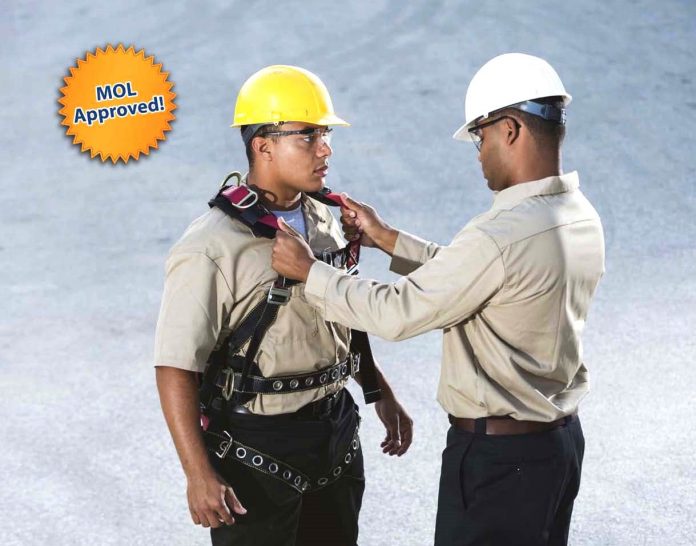Ottawa Construction News special feature
This year marks YOW Canada’s 16th anniversary providing health and safety training to help organizations meet their safety goals and keep in compliance. The company established a strong footprint in the training industry with two of its flagship programs: WHMIS (Workplace Hazardous Materials Information System) and TDG (Transportation of Dangerous Goods). Since then, the company has added in-demand programs as they arise, including the new required Working at Heights (WAH) training.
WAH has also been added as part of YOW’s online course offering, which also includes WHMIS, TDG, Confined Space Awareness, Fall Protection, Workplace Violence and Harassment, and Ontario Health and Safety Awareness among others.
Don Hoddinott, YOW Canada’s director of business development, attributes the company’s success to two things: “First, a singular dedicated focus, namely helping companies with their need to manage their occupational health and safety needs across our variety of high quality product lines.”
“Second, we continually look for ways to optimize our operations in every single area of the business to better meet our customers’ needs. Combined, this serves our customers and employees in the harmonized goal of promoting safer and healthier workplaces across Canada.”
Hoddinott says that online training provides the flexibility and convenience that makes it a preferred means of delivery for many learners. The addition of a course administration site allows employers to track their staff’s training. “YOW’s Learner Management System makes it easy for companies to meet their goals, while keeping their staff safe and in compliance.”
Hoddinott states that YOW Canada ensures all courses and training materials are up-to-date and that customers are advised of relevant regulatory changes affecting their employee training. This service, he says, in addition to excellent customer support and competitive pricing, makes YOW Canada Inc. stand out from the rest.
In addition, all courses are developed and reviewed by safety and industry professionals to ensure accuracy, relevancy and compliance to applicable laws and regulations. He says that YOW Canada spent about a year developing its WAH training and that YOW became the first provider to be certified for Blended Learning by the Ministry of Labour (MOL), allowing for the combination of online and practical WAH training.
“Blended Learning is a relatively new term. It came about when a great number of companies wanted online training for their employees but because of practical training requirements, online didn’t work. Some health and safety training topics simply cannot be done online.”
Hoddinott says, as dictated by the MOL, WAH must be at least 6.5 hours long. Blended Learning was adapted from the understanding that only about 50 per cent of the WAH training needed to be done in a practical hands-on atmosphere. “The other 50 per cent is theoretical which can be very easily done online from anywhere with an internet connection. This means trainees can log in from home, work or wherever is convenient for them.”
He says that Part 1 – Theory can be completed in about 3.5 hours at any time over many sessions if necessary. The trainees progress is saved automatically, therefore, they can log in and out as needed. Once Part 1 is successfully completed, the learner attends the Part 2 – Practical training, which is about four hours and can be conducted through a variety of classrooms throughout the province.
“Our headquarters in Ottawa includes a training facility for classroom training. We also have many satellite trainers throughout the province in various facilities with most of our classroom training delivered in eastern, central and southern Ontario.”
YOW Canada also offers onsite WAH training and will send trainer to the client’s location of choice.
WAH training is valid for three years at which point a four-hour refresher course is required. “This means that starting April 2018, there will be workers already needing refresher training. As a service to our customers, we email our contact within each company notifying them well in advance of a training certificate expiring.”
While some clients will soon be coming up for this renewal training, Hoddinott says many people are still unaware of the WAH requirement, which has an April 1, 2017 deadline. “Those who require the training will likely be turned away from worksites and possibly fined for non-compliance (both the worker and employer).”
YOW Canada also offers a unique Train-the-Trainer (TtT) course. “We believe that the best way to teach is to “tell, show and then get instructors to do.” During our two-day intensive Train-the-Trainer course, trainers learn how to deliver blended learning training, receive all required resources, and submit a training provider application to the MOL.”
This training includes an observation component so new trainers can see how the material should be delivered, and how the class should be managed. They are also given access to a YOW instructor in real-time so they can ask technical, or delivery related questions. “YOW Canada aims to establish a long-term relationship with those completing our TtT course, and to leverage our experience, and their experiences, to keep improving WAH delivery for learners. The TtT course is just the beginning.”
Since inception, he says YOW Canada has focused on the adage “find good workers, invest in them and retain them.” This means all of YOW’s employees, many of whom have been with the company for more than a decade, from regulatory specialists, marketing and sales members and technical/programmers, strive to go the extra mile. “Strong customer service is something that separates us from the rest of the pack and we receive very positive feedback.”
Developing training courses, he says, involves the whole team. “Many of our competitors simply buy up and resell courses from other organizations. The problem with that is that you can’t properly support a product unless you have become experts on the topics and regulations through every province and territory.”
Hoddinott says for this reason, and the rapidly changing regulatory requirements, YOW Canada’s courses are custom built to ensure complete accuracy. “Many of our customers across Canada have very specific or technical questions. Because we build our own courses, our regulatory specialists pride themselves on answering each and every inquiry, which is much appreciated by our customers. In short, we love what we do and look forward to doing it for many more decades.”
For more information, visit www.yowcanada.com, or call 1 (866) 688-2845.
Pull out
April 1st, 2017 is the WAH training deadline for all Ontario workers who work on construction projects. Because there are approximately 500,000 workers who are affected, on April 1st, 2015, the MOL, in introducing the new requirement, allowed for a two-year phase-in period.
According to the MOL, the training is required “for workers on construction projects who use any of the following methods of fall protection: travel restraint systems, fall restricting systems, fall arrest systems, safety nets or safety belts.”
Fall protection is required for any worker who may be: “Falling more than three meters; falling more than 1.2 meters, if the work area is used as a path for a wheelbarrow or similar equipment; falling into operating machinery; falling into water or another liquid; falling into or onto a hazardous substance or object; or falling through an opening on a work surface.”
More details are available at https://www.labour.gov.on.ca/english/hs/topics/heights.php.






